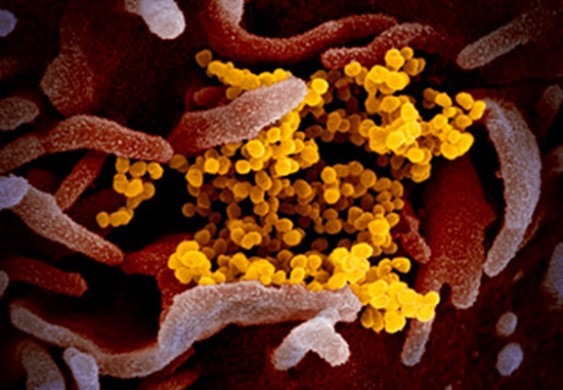Powering analyses, protecting patient information

the virus that causes COVID-19 - emerging from the surface of cells (pink)
cultured in the lab.
Image credit: National Institute of Allergy and Infectious Diseases
CRC prides itself on responsiveness, flexibility, and speed. The CRC team recently outdid itself putting together a complex set of computing resources for a COVID-19-related project for the Department of Biomedical Informatics (DBMI), led by Professor Greg Cooper with support from the Health Record Research Request team under Professor Jonathan Silverstein. CRC consultant and research faculty Kim Wong started from zero late on a Friday afternoon to having the resources in place in a matter of a few hours, in close collaboration with Pitt IT team members Jeff Raymond, Sasha Kessler, and Troy Caro,
The DBMI project sought to apply machine learning methods to analyzing UPMC Emergency Department reports from patients seeking clinical care before and during the COVID-19 outbreak. The team needed access to powerful computing, and because they work with Protected Health Information (PHI), they could not submit data to a computing cluster using standard procedures.
The DBMI team’s algorithm uses emergency department data in learning a critical set of epidemiological parameters – including latent period, infectious period, and R0, which at the beginning of an outbreak is the expected number of infections an infected person will transmit during their infectious period. The team can infer an epidemic curve to estimate the magnitude and timing of past, present, and future outcomes of interest for decision makers, including daily number of infected cases, hospitalizations, and deaths.
The project was high priority and urgent. The DBMI team needed rapid access to a large number of processors in order to dramatically reduce the analysis time, and they needed a customized path for submitting the PHI data. Late on a Friday afternoon, they reached out to Wong. Would CRC be able to help?
CRC offers priority consultations and resource allocations to researchers doing work related to COVID-19. Wong and the Pitt IT team dropped everything at 5 p.m. and had the system in place by 8 p.m. They carved out computing resources, allocated a dedicated storage pool, and configured and tested the application software. Crucially for working with PHI, they put in place security protocols that restricted access to this environment to authorized researchers and systems administrators. Pitt IT was able to use Pitt’s account on the Globus Connect file server system help the team meet some of the security requirements.
With CRC support, the DBMI group completed in four days an analysis which would otherwise take more than a month. The data from the initial analysis of emergency department records is being used to develop models for identifying patients who have COVID-19, including those emergency department patients who may have had COVID-19 but were undetected in the past.
“What really helped boost this effort,” says Wong, “were people working behind the scene to ensure that our implementation was sound and appropriate for protected health data.” Owing to the urgency of research on COVID-19, the Department of Health and Human Services has issued limited waivers of the Health Insurance Privacy and Portability Act (HIPAA) that ease some restrictions around working with PHI.
“We took full advantage of these waivers,” explains Wong. While Wong and team worked, Joel Garmon, Pitt’s Chief Information Security Officer, explained the security design to the Pitt Office of University Counsel.
“The protected computing environment we developed for the DBMI project falls within the special waivers issued for COVID-19-related research,” explains Wong. “But for other projects, CRC and Pitt IT are now exploring additional steps needed to upgrade the system to a fully HIPAA-compliant environment for using protected health information that could serve the broader Pitt research community – which would be a huge step in enabling health science research that is impossible now.”
Contact:
Brian Connelly
Center for Research Computing
bgc14@pitt.edu
